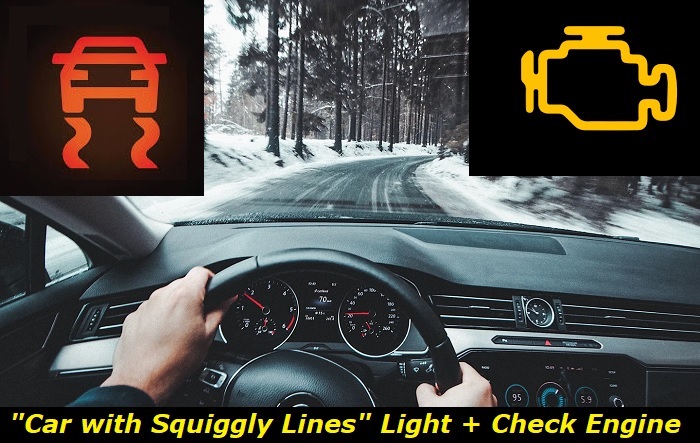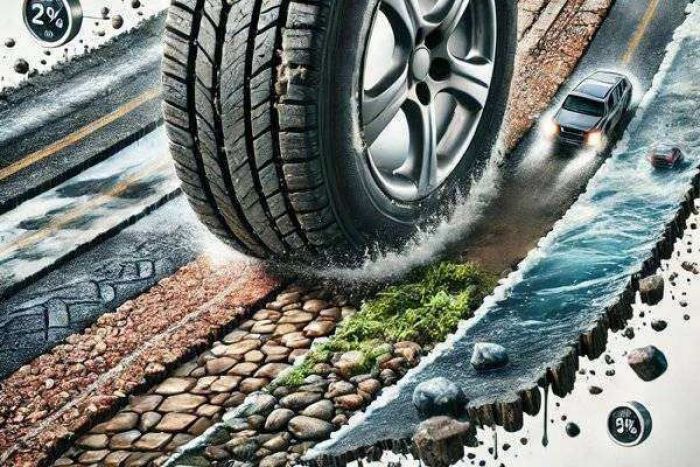Don't ignore your dashboard. Your car will communicate with you through the dashboard when there is something wrong with the control unit, the engine, the instrument cluster, the EVAP system, et cetera. The warning may come as illuminations on your dashboard. Some may be persistent, while others may be flashy. An example of such a warning is the "car with squiggly lines."
Traction control warning light highlights
- Common reasons:any problem with traction control
- How to fix:read the codes, check the obvious possible issues
- Possible consequences:traction control may not work
- Priority level:High
- Can you drive?Carefully
- DIY repair:Impossible
- Repair price range:$150-$450

What's a Traction Control and Check Engine Light
You should only see the traction control when driving during a rainy or snowy day. The traction control will track the car's steering wheel and stability as you maneuver it under slippery conditions. The traction control does this with the help of electronic sensors on its wheels.
The sensors will communicate with the car's power control module to control your automobile's stability. The traction control will minimize the car's speed and the brake pressure on its wheels to prevent it from sliding. It will also work concurrently with the ABS (anti-lock braking system) to further control your car's stability.
However, there could be an issue with your traction system if you see it on your dashboard as you drive under normal conditions. You may also observe a check engine illumination on your display unit.
The check engine may flash or be consistent on your dashboard. The check engine often indicates several problems with the engine or the car's computer system. Issues with the oxygen sensor, airflow sensor, ignition coil, thermostat, EVAP system, catalytic converters, et cetera may cause a check engine illumination on your dashboard.
The check engine illumination can also accompany other warning lights like the traction control.
ProTip: If you see traction control and check engine warnings on your display unit, you should get a thorough assessment. If possible, go for diagnostic codes. A diagnostic scanner will display all the errors recorded during the assessment process. These codes will give you reliable information to help you fix the "car with squiggly lines" and check engine warnings.
Why the Traction Control and Check Engine Light Appeared on the Dashboard
Here's why you're seeing the two warnings on your dashboard.
1) Failing Wheel Speed Sensors
Your automobile has sensors on its wheels that measure the wheels' rotational speed. They'll transmit this information to the vehicle's computer system. The computer, in turn, uses the data to measure the speed and the distance your car covers.
The computer system will use the information coming from the sensors to adjust your speed. It also uses the data to activate the traction control when you're under adverse weather.
Therefore, you'll need operable wheel speed sensors for the traction control to function as expected. Any damage to the sensor may push your car to limp mode or trigger the control light on your dashboard.
What Can Cause Failing Wheel Speed Sensors?
The wheel speed sensors often wear out because of road debris. A single strike can severely damage the sensors. A loose connection on the sensor can also cause the traction control and a check engine illumination. Low battery voltage, a burned ABS motor, a bad sensor wire, or a bad ABS module can also cause a malfunctioning wheel speed sensor.
Apart from the traction control and check engine warnings, you'll also notice that your ABS is disabled. An ABS light may also appear on your dashboard. Bad wheel sensors may also negatively impact the speedometer.
How To Diagnose and Fix Bad Wheel Speed Sensor?
An OBD-11 scanner can help you diagnose a bad wheel sensor. The scanner will display all the codes that can help pinpoint the real issue with the wheel speed sensor. Check all the speed sensors. The problem may emerge from one of the wheel speed sensors. In such a case, you'll have to replace the damaged sensors and clean the rest.
You may need further diagnosis if the traction control and check engine are still on your display unit. Check the wiring harness. You can also take it to a qualified mechanic for further diagnosis.
2) Inadequate Tire Pressure
Low tire pressure on your wheels often triggers the traction control and check engine warning. Low tire pressure decreases the car's fuel efficiency, causes a toll on your suspensions, increases wear, et cetera. Also, if one or all the tires have low pressure, it can trigger the traction control illumination because of the poor contact between the road surface and the tires.
Inflating your tires will fix the low tire pressure. However, take the car to a repair shop for further assessment if the check engine and traction control warning persist on your dashboard.
3) A Malfunctioning Traction Control Computer
A traction control illumination is a common sign of a faulty traction control module. Your car will need a working traction control module to stabilize it when driving under adverse conditions. All the components work to stabilize as you maneuver under adverse weather conditions. So, damage to the traction control module triggers the traction light warning on your dashboard. A check engine warning may also accompany the traction control illumination.
Apart from the traction control light, you may also notice that the illumination remains on despite turning the traction control off. A qualified mechanic can help you check and see if your traction control computer has a problem.
4) A Failing Anti-Lock Brake System
The traction control and the ABS will help stabilize your car as you drive through a slippery road surface. You'll need to use them when driving. Therefore, a problem with the ABS may trigger the traction control illumination on your dashboard. It can also trigger the check engine warning.
The ABS may fail because of a wrongly fixed or damaged wiring harness, debris, or brake dust. Your mechanic will work to identify the issues with your ABS.
They'll go ahead and repair or replace the failing ABS.
5) You've Accidentally Switched Off the Traction Control While Driving Under Slippery Conditions
You'll need traction control when driving on a slippery road. Therefore, the "car with squiggly lines" and check engine light will appear on your dash if you accidentally switch off the traction control despite needing it.
6) PCM or the Car's Central Computer Issues
The traction system relies on sensors, PCM, and the car's computer system. The car's computer system will determine if your vehicle will be stable if you drive it on an icy or rain-filled road surface. So if the ABS or the traction control unit is working as expected, you'll need to shift your focus on the central computer system.
A communication error between the PCM or the vehicle's computer system and traction control may trigger the "Car with squiggly lines" and check engine lights on your dashboard. Get a mechanic to diagnose the PCM or the car's computer to pinpoint what may be causing the warnings on your display unit.
7) A Burned Fuse
Minute damages to a traction controller, like blown fuses, may trigger the traction light warning on your dashboard. The traction control and the ABS have fuses that control the electric current flowing to and from the two components.
Therefore, damage to one of the fuses that allow the traction control to operate as expected may cause the traction control to misbehave. The engine's internal self-diagnostic system will also pick up the burned fuse. Therefore, your dashboard will display the two warnings on your dashboard.
A qualified mechanic will help you assess the fuses and replace any damaged fuse.
A Recap
It's vital to remember that while the check engine doesn't necessarily indicate a significant problem, you shouldn't ignore it. A fault in the traction control may cause severe problems to the engine. On top of that, it may cause your wheels to slip.
Therefore, putting your and all the car occupants in danger. Also, your engine may have to strain to control your wheels as you drive under slippery conditions causing further damage to the engine and its fuel efficiency.
However, don't ignore it when it accompanies another warning like the traction control warning. It's advisable to take your automobile to a mechanic or examine it as soon as traction control and check engine illumination pop up on your dashboard. Ignoring the two warnings may lead to more significant problems or put your car in limp mode.
Regular checks and repairs can prevent the traction control from damaging your engine. Therefore, it is essential to maintain your vehicle regularly. The maintenance will avert problems that may cause the traction control or check engine to illuminate unexpectedly.
About the authors
The CarAraC research team is composed of seasoned auto mechanics and automotive industry professionals, including individuals with advanced degrees and certifications in their field. Our team members boast prestigious credentials, reflecting their extensive knowledge and skills. These qualifications include: IMI: Institute of the Motor Industry, ASE-Certified Master Automobile Technicians; Coventry University, Graduate of MA in Automotive Journalism; Politecnico di Torino, Italy, MS Automotive Engineering; Ss. Cyril and Methodius University in Skopje, Mechanical University in Skopje; TOC Automotive College; DHA Suffa University, Department of Mechanical Engineering






Add comment